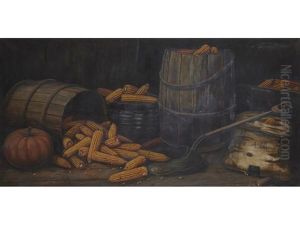Alfred Montgomery Paintings
Alfred Montgomery was an American painter known for his still life and portrait paintings. Born in Cincinnati, Ohio, in 1857, Montgomery showed an early interest in art, which was nurtured by his environment and the burgeoning art community in Cincinnati at the time. He initially trained under local artists, honing his skills in various art forms before focusing on painting.
Montgomery's work is characterized by its detailed realism and vibrant colors, often featuring flowers, fruits, and objects arranged in intricate compositions. His still lifes, in particular, are noted for their texture, depth, and the ability of Montgomery to capture the interplay of light and shadow. Alongside still lifes, Montgomery also painted portraits, capturing the essence of his subjects with a similar level of detail and realism.
In the late 19th and early 20th centuries, Montgomery became a prominent figure in the American art scene, participating in various exhibitions and gaining recognition for his work. He was a member of several art organizations and societies, which helped to further his career and establish his reputation as a skilled painter.
Despite his success, Montgomery's work is less known today than that of some of his contemporaries. However, his contributions to American art, particularly in the realm of still life painting, continue to be appreciated by art historians and collectors. Montgomery's paintings are held in several art museums and private collections, where they are celebrated for their beauty and technical prowess.
Alfred Montgomery passed away in 1922, leaving behind a legacy of artistic excellence. His meticulous approach to painting, combined with his mastery of color and composition, make his works a significant part of American art history.






























